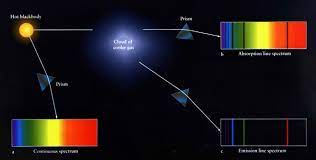
|
SPECTRAL FORMATIONKirchhoff's Laws |

|
SPECTRAL FORMATIONKirchhoff's Laws |
Kirchhoff's Laws:
Law I: A hot opaque body, such as a hot, dense gas (like a lightbulb) or a hot solid material (like the coils on your electric stove) produces a continuous spectrum
 |
 |
Law II: A hot, transparent gas produces an emission line spectrum. A nice example is the hot gas cloud surrounding the Crab pulsar and its spectrum. The Crab nebula is dark is except at well-defined wavelengths.

|

|
Law III: A cool, transparent (dilute) gas in front of a hotter source of continuous emission produces an absorption line spectrum. Law III roughly describes the spectra of normal stars where a lower density, cooler layer of gas surrounds how the hot dense interior of the star. Examples of such spectra for a range of stars is shown below right.
 |
 |

| The notion that the continuous emission from stars comes from the dense, hot regions of the star while the absorption lines are formed in cooler layers overlying the opaque regions. This picture is roughly correct, however, we know that it is an oversimplification. In reality, the continuum and the spectral lines are formed over larger regions and the regions over which they are formed are not distinct from one and another. |
